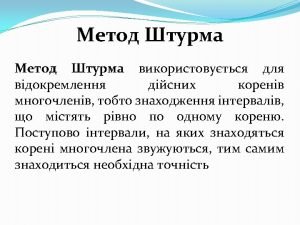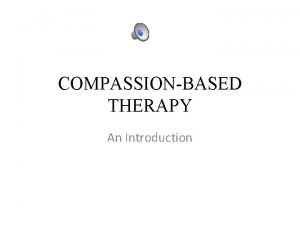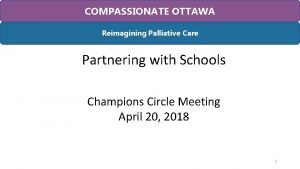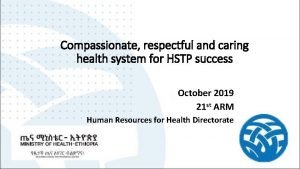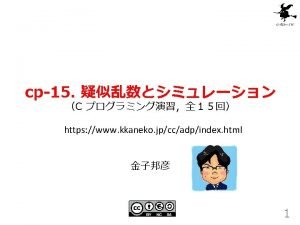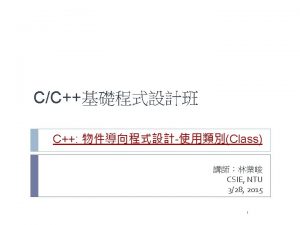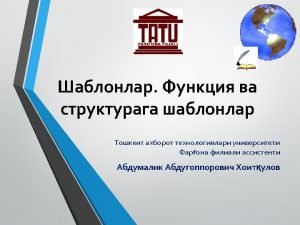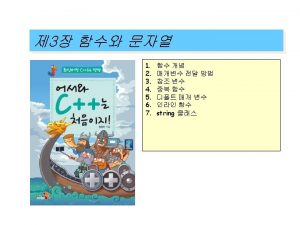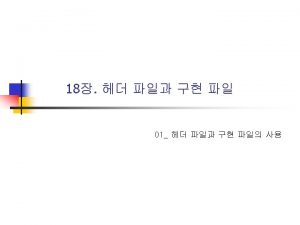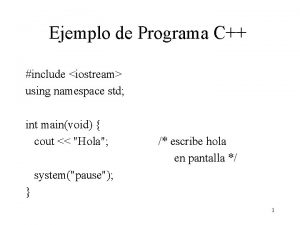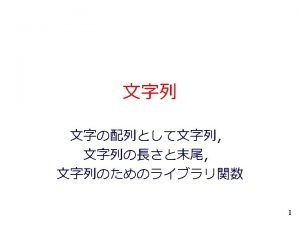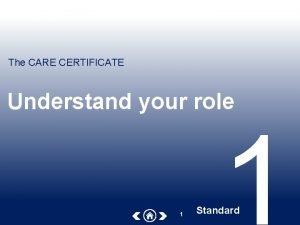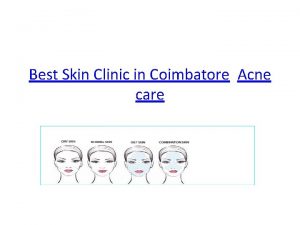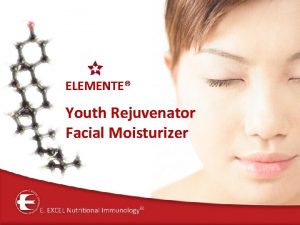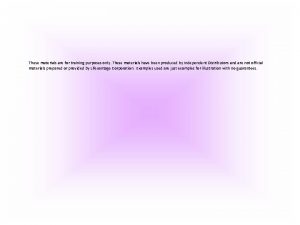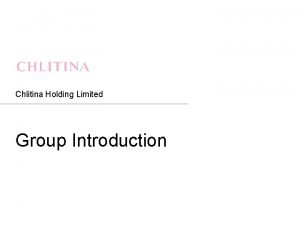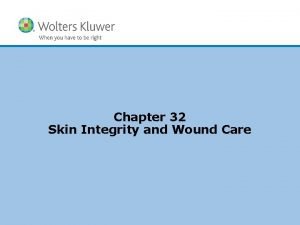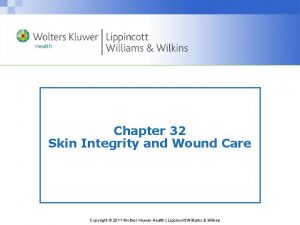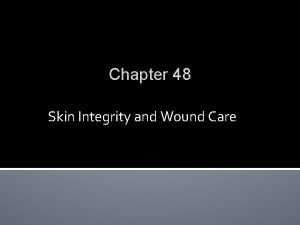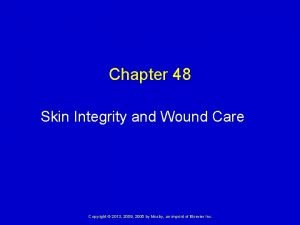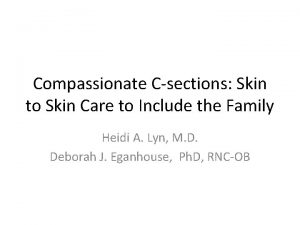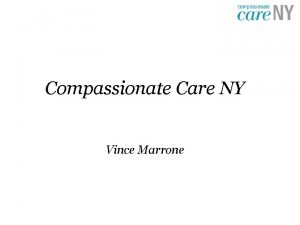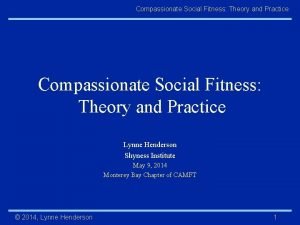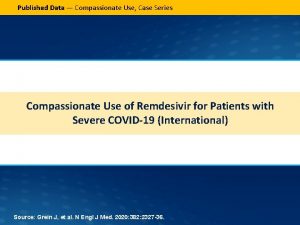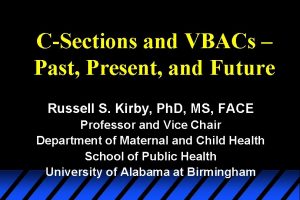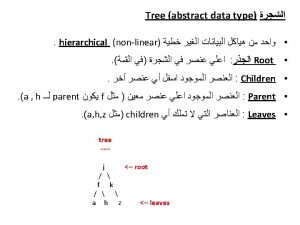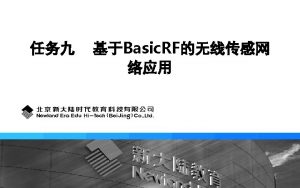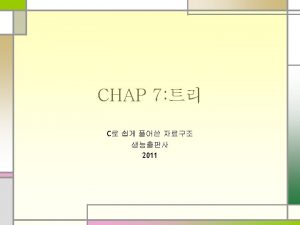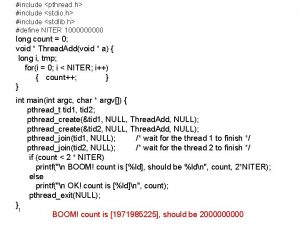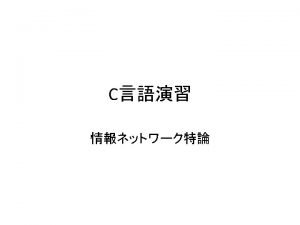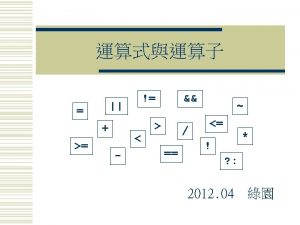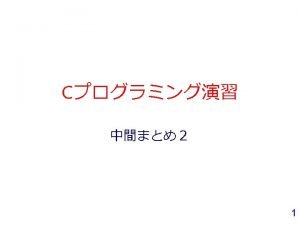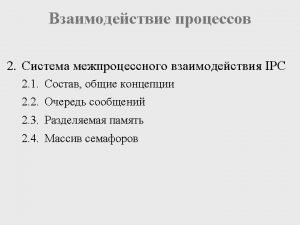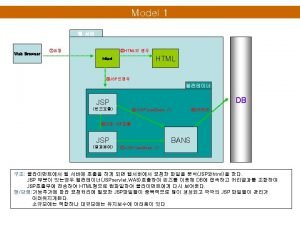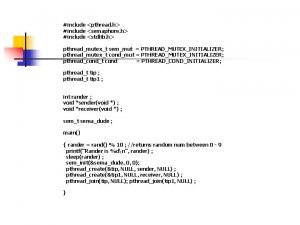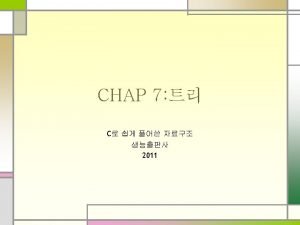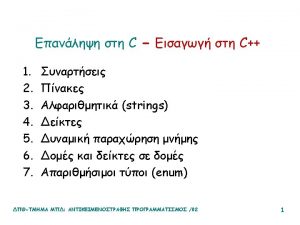Compassionate Csections Skin to Skin Care to Include















































- Slides: 47

Compassionate C-sections: Skin to Skin Care to Include the Family Heidi A. Lyn, M. D. Deborah J. Eganhouse, Ph. D, RNC-OB

Objectives • Describe the positive physiological benefits of skin-to-skin (STS) care. • Describe the positive psychological benefits of STS care. • Define interventions in the operative suite that enhance the birth experience. • Define interventions in patient hand-off that enhance family-centered care.

The Natural Caesarean • Originally described by Smith, Plaat and Fisk • 2008 • Australia

Preparation OR tour for patient and partner Patient may provide music of her choice Patient may wear her own clothing IV in non-dominant arm EKG leads away from maternal anterior chest wall • Pulse oximeter on mother’s foot • Mothers arms not strapped down • • •

Delivery • The mother’s head is raised and the drape lowered • The fetal head enters the abdominal incision • The fetus auto-resuscitates • After crying, delivery of the torso is assisted • The fetus is half delivered for up to a minute • Passive and active birth continue • The cord is clamped and cut



Immediate Skin to Skin • A scrubbed midwife moves to the head of the bed and takes the baby from the surgeon • The baby is placed between the mother’s breasts • The baby is dried with warm towels • Hospital bands, vitamin K are done with the newborn on the maternal chest • Breastfeeding is facilitated • Weighing is delayed

Maternal Benefits of STS • Reduced anxiety • Increased mutuality and reciprocity with the neonate • Preference for STS with subsequent births • Higher breastfeeding rates • Greater patient satisfaction

STS in the OR, and breastfeeding • Of 4 QI projects and one RCT evaluating the breastfeeding rate, 3 demonstrated an increase in the breastfeeding rate at hospital discharge.

Delayed Cord Clamping • Neonates who had delayed cord clamping during cesarean birth ( more than 30 sec) had the same residual blood volume as those who had immediate cord clamping • 3 RCT demonstrated higher blood volume, initial mean blood pressure, and mean glucose levels • Note: neonate was held at or below the level of the incision

Autoresuscitation • No significant differences in p. H, or Apgar scores • May increase placental transfusion to the neonate during the slower expulsion, resulting in increased red blood cell mass ( one study)

Delayed Cord Clamping • Neonates who had delayed cord clamping during cesarean birth ( more than 30 sec) had the same residual blood volume as those who had immediate cord clamping • 3 RCT demonstrated higher blood volume, initial mean blood pressure, and mean glucose levels • Note: neonate was held at or below the level of the incision

Neonatal Temperature • Vanderbilt modification: 5 minute assessment is done before skin to skin • Baby is dried under a warmer • Baby is placed skin to skin with mother, and covered with warm blankets and/or a forced air warming system • Rectal temperatures in a medical record review of 47 neonates showed all had normal rectal temperatures at conclusion of skin to skin

Implementation of STS in the OR: Identify Stakeholders Anesthesia services Community doula Family advocate L&D nurse Neonatal NP Neonatologist Nurse from newborn nursery Physician from newborn nursery Nurse midwife Obstetrician Scrub technician Women’s services administrator

Implementation • In US, a windowed drape has been adopted at many institutions • 5 minute delay in STS for drying and assessment • Kangaroo care • Family centered cesarean birth nurse: dedicated personnel


UMC is A Texas Ten Step Hospital

What is the Baby-Friendly Hospital Initiative (BFHI)? • A recognition program for maternity facilities that have created an optimal environment for appropriate infant feeding and mother-baby bonding. • An international program co-administered by the World Health Organization (WHO) and the United Nations Children’s Fund (UNICEF) in conjunction with national BFHI authorities. 19 Copyright 2010 Baby-Friendly USA, Inc. 19

20 20


UMC-El Paso Baby-Friendly® 2015 • • • Designation rec’d July 7, 2015 1 st hospital in El Paso 3 rd US-MX Border Hospital 11 th Hospital in Texas 277 th Hospital in U. S. 22

Why Breastfeeding is Important Diabetes is reduced Over-feeding and obesity is reduced Babies are more healthy APA “babies first vaccine” Risks for uterine and breast cancer are reduced • Less cost and no preparation • Babies receive the best start regardless of socio-economic status • • • 23

Definition of STS • Placement of a naked infant (cap on) • Against the mother’s bare skin • Exposed mother and infant are covered with a warm blanket or towels • Kangaroo care generally refers to care of the preterm infant in NICUs • Should be implemented immediately following birth • Should not be interrupted by healthcare routines until after the first feed

Breastfeeding Issues & C-Birth • Less likely to initiate breastfeeding • Report more difficulties while establishing BF • Delay in breastfeeding initiation is associated with delayed lactogenesis stage and duration of breastfeeding.

Healthy People 2020 Goals 26 http: //www. cdc. gov/breastfeeding/data/reportcard. htm

Benchmarks 90 %

Maternity Practices in Infant Nutrition & Care External Benchmark • CDC Survey: “Voluntary, ” confidential, data aggregated by state for regional comparisons • Ranked for US, state & size of hospital • Began in 2007, 2009, 2011, 2013, 2015 • Purpose: 2003, an expert panel of researchers with experience in surveillance and monitoring of hospital practices related to breastfeeding convened by CDC recommended establishment of an ongoing, national system to monitor and evaluate hospital practices related to breastfeeding among all facilities that routinely provide intrapartum care in the United States

m. PINC Scores & Ranks TX & UMC Year TX Comp. Score TX % Rank UMC Comp. Score UMC US % Rank UMC TX % Rank 2013 73 33 92 90 92 2011 66 36 65 37 47 2009 62 33 2007 58 39

Cesarean Birth Questions from m. PINC Approximately how many mothers are encouraged to hold their healthy full-term infants STS for at least 30 minutes within 2 hours after delivery for uncomplicated cesarean births? Rarely (0 -9%) Sometimes (10 -49%) Often (50%-89%) Almost Always (90%-100%)

Baby-Friendly Criteria--Interview • Step 4: Help mothers initiate breastfeeding within one hour of birth. • Guideline: After cesarean birth mothers will report that their babies were place in continuous uninterrupted STS contact…. as soon as the mother was responsive. • Criteria : At least 80% will confirm that their babies were placed in STS contact with them as soon as the mother was responsive…. .

Uncomplicated V-Birth & C-Birth (Couplets) 90 80 70 60 50 V-birth 40 C-Birth 30 20 10 0 Q 1 -13 Q 2 -13 Q 3 -13 Q 4 -13 Q 1 -13 Q 2 -14 Q 3 -14 Q 4 -14

Complicated (Separated) V-Birth & C-Births 2013 -2014

Skin-To-Skin—”Its Love…. ”


Skin to Skin During C/S

11 -25 -13 Latch in the UMC OR

Dad Meets his New Baby

RN to RN Report in the M/B Room

STS Rates for V-Births & C-Births 1 -13 to 12 -14 (97% vs. 90%) 120% 100% 80% V-Birth 60% C-Birth BFHI 40% 20% 0% Q 1 -13 Q 2 -13 Q 3 -13 Q 4 -13 Q 1 -14 Q 2 -14 Q 3 -14 Q 4 -14

C-Birth STS & Breastmilk as First Feed Rates-2013 -2014 (90% 83%) 100% 90% 80% 70% 60% STS 50% BM-1 st 40% BFHI 30% 20% 10% 0% Q 1 -13 Q 2 -13 Q 3 -13 Q 4 -13 Q 1 -14 Q 2 -14 Q 3 -14 Q 4 -14

Breastmilk as First Feed V (93%) & C-Birth (83%)— 2014 to 2015 120% 100% 80% V-Birth 60% C-Birth BFHI 40% 20% 0% Q 1 Q 2 Q 3 Q 4

UMC Couplet Transfer—L&D to MBU--2013 to 2014 120 100 80 V-birth 60 C-birth BFHI 40 20 0 Q 1 -13 Q 2 -13 Q 3 -13 Q 4 -13 Q 1 -14 Q 2 -14 Q 3 -14 Q 4 -14

What’s Next? 82 88 90 80 70 50 60 50 H. P. 2020 40 UMC 14 30 20 15 8 10 0 Ever Formula BFHI

Exclusive Breastfeeding Rate @ Discharge 2012 -2015 60 49 50 41 40 30 46 46 41 34 23 25 27 27 26 20 20 14 23 13 Q 1 Q 2 2015 2016 13 Q 3 2014 22 10 0 2012 Q 4

Keeping the Momentum • Quarterly data must be submitted to BFHI • 2020 is the year of re-designation • Documentation of medical indication for supplementation is required. • Education for new residents and faculty • Be an advocate for breastfeeding in the clinic and the hospital 46

 #include stdio.h #include conio.h #include stdlib.h
#include stdio.h #include conio.h #include stdlib.h Primary secondary tertiary health care
Primary secondary tertiary health care Allahumma izzal islama wal muslimeen
Allahumma izzal islama wal muslimeen The most compassionate
The most compassionate Exams office uoa
Exams office uoa In the name of allah the compassionate the merciful
In the name of allah the compassionate the merciful Compassionate capitalism definition
Compassionate capitalism definition Example of compassionate letter to yourself
Example of compassionate letter to yourself Allah the compassionate
Allah the compassionate Pallatie
Pallatie Compassionate ottawa
Compassionate ottawa Compassionate respectful and caring
Compassionate respectful and caring Include stdlib.h
Include stdlib.h Include iostream using namespace std
Include iostream using namespace std Include stdlib h
Include stdlib h #include iostream #include string using namespace std
#include iostream #include string using namespace std Include string
Include string Std::endl
Std::endl #include iostream #include cmath
#include iostream #include cmath Include iostrem
Include iostrem Include stdio.h
Include stdio.h Organum germinativum
Organum germinativum Thin skin vs thick skin
Thin skin vs thick skin Milady chapter 23 textbook
Milady chapter 23 textbook Understand your role care certificate
Understand your role care certificate Conclusion of skin care
Conclusion of skin care Best skin care clinic in coimbatore
Best skin care clinic in coimbatore Elemente skin care
Elemente skin care Training purposes only
Training purposes only The skin theory
The skin theory Royal skin care
Royal skin care Chlitina
Chlitina Serosanguineous vs serous
Serosanguineous vs serous Chapter 48 skin integrity and wound care
Chapter 48 skin integrity and wound care Chapter 48 skin integrity and wound care
Chapter 48 skin integrity and wound care Chapter 48 skin integrity and wound care
Chapter 48 skin integrity and wound care Basic skin care definition
Basic skin care definition During the skin analysis procedure cleansing milk
During the skin analysis procedure cleansing milk Unit 2 equality diversity and rights
Unit 2 equality diversity and rights Care sunt simturile prin care sunt evocate
Care sunt simturile prin care sunt evocate Magnetii atrag fierul
Magnetii atrag fierul Care certificate standard 13 answers
Care certificate standard 13 answers
